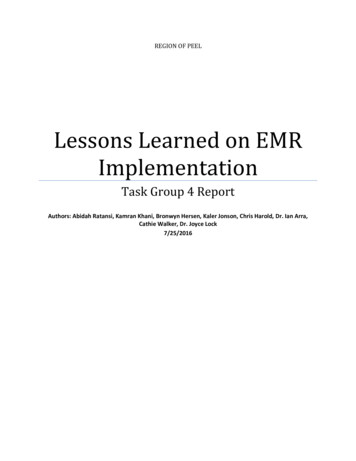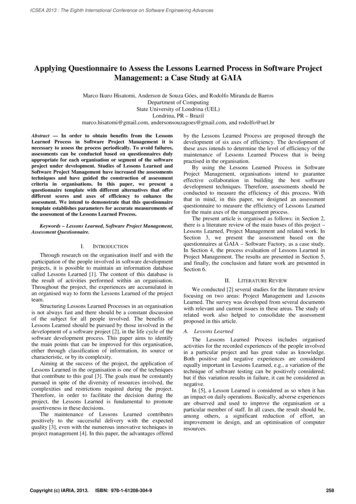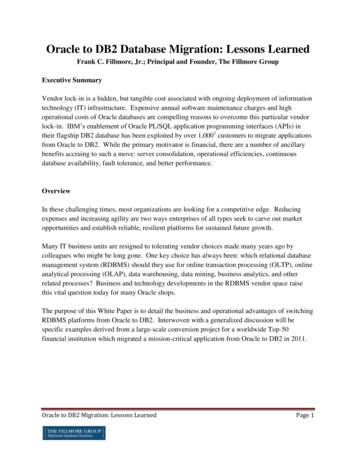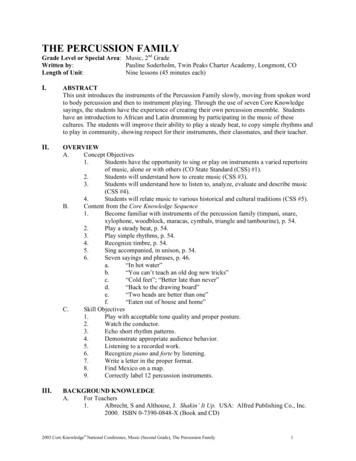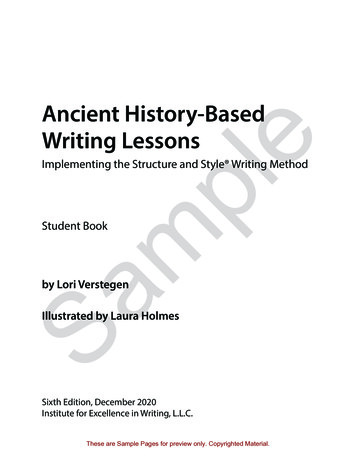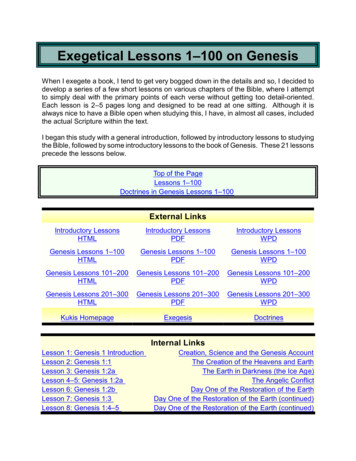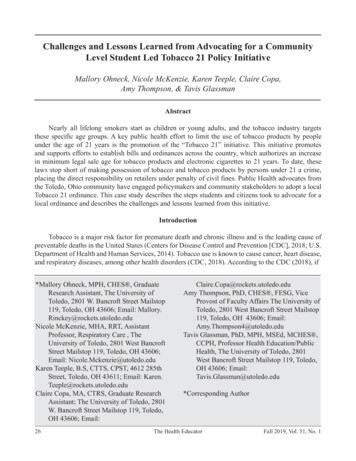
Transcription
Challenges and Lessons Learned from Advocating for a CommunityLevel Student Led Tobacco 21 Policy InitiativeMallory Ohneck, Nicole McKenzie, Karen Teeple, Claire Copa,Amy Thompson, & Tavis GlassmanAbstractNearly all lifelong smokers start as children or young adults, and the tobacco industry targetsthese specific age groups. A key public health effort to limit the use of tobacco products by peopleunder the age of 21 years is the promotion of the “Tobacco 21” initiative. This initiative promotesand supports efforts to establish bills and ordinances across the country, which authorizes an increasein minimum legal sale age for tobacco products and electronic cigarettes to 21 years. To date, theselaws stop short of making possession of tobacco and tobacco products by persons under 21 a crime,placing the direct responsibility on retailers under penalty of civil fines. Public Health advocates fromthe Toledo, Ohio community have engaged policymakers and community stakeholders to adopt a localTobacco 21 ordinance. This case study describes the steps students and citizens took to advocate for alocal ordinance and describes the challenges and lessons learned from this initiative.IntroductionTobacco is a major risk factor for premature death and chronic illness and is the leading cause ofpreventable deaths in the United States (Centers for Disease Control and Prevention [CDC], 2018; U.S.Department of Health and Human Services, 2014). Tobacco use is known to cause cancer, heart disease,and respiratory diseases, among other health disorders (CDC, 2018). According to the CDC (2018), if*Mallory Ohneck, MPH, CHES , GraduateResearch Assistant, The University ofToledo, 2801 W. Bancroft Street Mailstop119, Toledo, OH 43606; Email: Mallory.Rinckey@rockets.utoledo.eduNicole McKenzie, MHA, RRT, AssistantProfessor, Respiratory Care , TheUniversity of Toledo, 2801 West BancroftStreet Mailstop 119, Toledo, OH 43606;Email: Nicole.Mckenzie@utoledo.eduKaren Teeple, B.S, CTTS, CPST, 4612 285thStreet, Toledo, OH 43611; Email: Karen.Teeple@rockets.utoledo.eduClaire Copa, MA, CTRS, Graduate ResearchAssistant; The University of Toledo, 2801W. Bancroft Street Mailstop 119, Toledo,OH 43606; Email:26Claire.Copa@rockets.utoledo.eduAmy Thompson, PhD, CHES , FESG, ViceProvost of Faculty Affairs The University ofToledo, 2801 West Bancroft Street Mailstop119, Toledo, OH 43606; Email:Amy.Thompson4@utoledo.eduTavis Glassman, PhD, MPH, MSEd, MCHES ,CCPH, Professor Health Education/PublicHealth, The University of Toledo, 2801West Bancroft Street Mailstop 119, Toledo,OH 43606; Email:Tavis.Glassman@utoledo.edu*Corresponding AuthorThe Health EducatorFall 2019, Vol. 51, No. 1
the prevalence of smoking continues at thecurrent rate, 5.6 million youth under the age of18 will die early from a smoking-related illness.Delaying the age when youth first experimentwith tobacco products may reduce the risk ofadolescents transitioning to a daily adult smoker(Institute of Medicine [IOM], 2015; Schneider,Buka, Dash, Winickoff, and O’Donnell, 2016).Youth are susceptible to the addictive effects ofnicotine, and human brains continue to developthrough the age of 25 (IOM, 2015; Feinstein,Richter, and Foster, 2012). From an addictionperspective, the cerebral cortex, the area of thebrain responsible for decision making, impulsecontrol, sensation seeking, and susceptibility topeer pressure is vulnerable to nicotine duringadolescence and early adulthood (IOM, 2015;Feinstein et al., 2012). Thus, local/state policiesor ordinances called Tobacco 21 aim to limitthe sale and distribution of cigarettes, tobaccoproducts, e-cigarettes, and liquid nicotine toindividuals under the age of 21 years old. Thesepolicies minimize tobacco accessibility to minors,as many young adult smokers (18 to 21-yearolds) serve as a social resource for acquisitionof tobacco (IOM, 2015; Schneider et al., 2016).Combating the tobacco epidemic, particularlyyouth smoking, by advocating for policy change,is a direct effort to create environments conduciveto healthier behaviors. While there have beenseveral articles published that show the impact ofTobacco 21 laws on the reduction in adolescenttobacco use, there is a dearth of research on thesteps used to pass such a law or lessons learned(Schneider et al., 2016; Moreland-Russell,Combs, Schroth, and Luke, 2016; IOM, 2015).Tobacco 21 Policies in the United StatesIn 2005, the first community to increasethe minimum sale age of tobacco and nicotineproducts was Needham, Massachusetts. Thetobacco smoking rate for past 30-day use amongthe high school students in Needham decreasedfrom 12.9% in 2006 to 5.5% in 2012 (Schneideret al., 2016). In effect, the law blocked the socialsources that provided the Needham youth withFall 2019, Vol. 51, No. 1tobacco products. To date, there are over 475cities and 18 states that have adopted a Tobacco21 ordinance (Preventing Tobacco AddictionFoundation, 2019). Before Ohio passed astatewide policy, 24 cities adopted the Tobacco21 ordinance, but none in the northwest cornerof the state (Preventing Tobacco AddictionFoundation, 2019). Due to the advocacy effortstaking place throughout the state, in July 2019,Ohio’s governor passed Tobacco 21 legislationto take effect in October 2019 (FY 2020-2021Operating Budget, 2019).Tobacco 21 Policies in Toledo, OhioAdvocacy for Tobacco 21 in Toledo beganas a classroom assignment at the University ofToledo in a graduate-level public health coursein 2015. The assignment required researchingTobacco 21 and talking to one city council memberto learn advocacy skills and how local policies arepassed. The project continued after the semesterended and grew the collaborative effort to includemany dedicated public health students, includingthe university’s Eta Sigma Gamma chapter,faculty members, and community public healthprofessionals and enact this important publichealth policy. Figure 1 provides a chronologyof the steps implemented as a part of the ToledoTobacco 21 initiative.Student responsibilities included creatingan advocacy packet to use during meetingswith city council members, collecting letters ofsupport, and writing opinion editorials for localnewspapers. Materials were created during onesemester and updated or amended throughout thecampaign. Individual meetings with city councilpresidents and members, chiefs of staff, cityadministrators, and community members werethe starting point for advocacy using the materialscreated by students. Students and facultyadvocated with policymakers to implement aTobacco 21 ordinance. The Toledo efforts beganwith students collecting background informationand organizing a plan, later forming an integralpartnership with the Toledo-Lucas County HealthDepartment in March 2017.The Health Educator27
28The Health EducatorFall 2019, Vol. 51, No. 1
The advocacy approaches used in thisstudy are unique including: 1) the communityadvocacy efforts were student driven - Universityof Toledo students and local high school studentswere leaders; 2) Holding city council meetingsat a local high school to involve youth in theadvocacy efforts; 3) Students worked alongsidethe local health department and led the initiative;4) Students were the spokespeople for most ofthe media advocacy; 5) Students collected datafrom the community regarding local supportfor the Tobacco 21 that was used to advocatefor passaging the law; 6) Students planned,implemented and evaluated a Tobacco 21 Summitwhere they invited local officials and communitystakeholders to attend and participate; and 7)Students successfully advocated for the passageof a Student Government Resolution to supportTobacco 21. This case study informs universityhealth education/public health faculty or localeducators on how to plan and implement aTobacco 21 policy in the community. This study,presented as a commentary of advocacy strategies,shares information from lessons learned and didnot entail human subjects.Strategies for SuccessThroughout the initiative, students workedwith faculty members to develop successfulstrategies. The Tobacco 21 advocacy team usedevidence from the literature and learned by trialand error the most effective strategies in creatingchange (Gielen and Green, 2015). Studentsadapted initiative tactics based on the changingpolitical and social landscape within the Toledocommunity. By being organized and strategizingahead of time, students advanced the initiative bymobilizing public health advocates, communitymembers, and the media. Below is a list of keystrategies for a successful advocacy initiative.Identify a Consistent Point PersonThe advocacy initiative had a student as aconsistent point person in the community to helporganize and schedule meetings and send updatesFall 2019, Vol. 51, No. 1to community partners. This student point personkept a record of meetings and contacted citycouncil to schedule meetings. The point personalso kept the initiative moving forward when newstudents became engaged in advocacy.Develop PartnershipsThe second strategy was buildingpartnerships with public health agencies andorganizations. The partners provided letters ofsupport, testimony at city council meetings,and professional guidance. The partnersinvolved include: Preventing Tobacco AddictionFoundation, the previous Northwest OhioTobacco Prevention Coalition, the HealthyYouth and Family Coalition, Eta Sigma GammaIota Chapter, the University of Toledo StudentOrganization Students for Drug Free Policy, andthe Toledo-Lucas County Health Department.Secure Grant FundingNext, students wrote a successful grantproposal under the guidance of faculty to anOhio agency, the Prevention Action Alliance(previously the Drug Free Action Alliance), toimplement a social norms marketing campaign.A doctoral health education student developedthree billboard social norm message designs andundergraduate and graduate Eta Sigma GammaIota Chapter students assisted with testing themessages by using central intercept interviewswith the target audience through an onlinequestionnaire and in-person interviews. Basedon the feedback from message testing, a graphicdesign artist made revisions. The final messagewas displayed on nine billboards for four weeksacross the Greater Toledo Area with 4,634,124impressions.Engage the CommunityStudents and faculty organized communityforums to raise awareness, educate, and advocatefor Tobacco 21 in the community. The firstcommunity forum, attended by 65 people,included employees of local health agencies andstudents. The second forum was held to strategizeThe Health Educator29
with city council members on how to movethis initiative forward in Toledo. One powerfuldemonstration of community support occurred ata city council committee meeting at a local highschool. The high school students wore t-shirtsprovided by a community partner, each shirt witha unique written fact about adolescent smokingthat the students read to council members.The youth engagement in public testimonyparticularly impressed the Council members.Engage the MediaLast, students and faculty engaged themedia through interviews on TV, newspaper,and radio stations. Throughout the course of theinitiative, reporters from various local mediaoutlets covering the advocacy project contactedstudents and faculty. Students took the lead rolein speaking with reporters and gained valuableexperience in how to work with the media byusing talking points to advance policy efforts.Lessons LearnedAlong with the initiative’s success, it is alsoimportant for students to recognize the campaign’sweaknesses to make changes promptly. Duringinitial planning, it is important to conduct a needsassessment and determine how similar initiativeshave fared so the same mistakes will not bemade. Recently passed ordinances may impactfuture prevention efforts because in Toledo, citycouncil members were hesitant to implementanother health policy because of fatigue andfear of opposition following a controversiallead ordinance. The following points are the keylessons learned based on unique experienceswhile advocating for Tobacco 21.Identify GatekeepersIdentify gatekeepers and stakeholders inthe community early on. Knowing who theinfluential people in the community are andconnecting with them is a fundamental first step.Building relationships with city council membersand educating them about the nuances associated30with the proposed policy is essential. Findinga champion within city council that identifiesTobacco 21 as an important issue will help whengetting buy-in from other members of city council.The champion can expedite communication withcity council to move the ordinance forward andimprove accountability. This person can alsoprovide guidance for navigating and overcomingbarriers within the political process.Develop Clear MessagingDevelopment of clear messaging is a veryimportant lesson learned while advocating forTobacco 21. Advocates should have key pointsthat highlight the positive impact and successfuloutcomes of passing ordinances in other cities.Advocates should use the research as publishedfrom sources such as the CDC and the PreventingTobacco Addiction Foundation, with the neweststatistics on the benefits of passing Tobacco 21ordinances (CDC, 2018; Preventing TobaccoAddiction Foundation, 2019).Prioritize ResourcesAdvocacy efforts were more effective whenconcentrated rather than spread out. Initially,students advocated in five different cities inLucas County. However, it was quickly realizedthat the amount of work needed to pass a Tobacco21 ordinance was not manageable. Once thefocus was on only one city, resources were morewisely used and advocates had time to attendmeetings as a group instead of dividing the work.In hindsight, advocates should have started withToledo and been persistent with moving onecity’s advocacy initiative forward.Coordinate EarlyIt is critical to get letters of support fromlocal agencies, school superintendents, hospitalsystems, and medical professionals beforemeeting with city council members. Studentsfound it was easier to have the letter beforemeetings because there is a lengthy process toobtain a letter from a hospital system. Large localemployers were impactful to city council becauseThe Health EducatorFall 2019, Vol. 51, No. 1
of their influence on the city’s economy.Provide Model PoliciesProvide a sample of ordinances fromcomparable cities or state. Including a modelordinance in the advocacy packet helpspolicymakers have an example of what haspreviously passed in other locations. Policymakerscan adapt the model to fit the unique needs oftheir community. In this advocacy initiative,policymakers were most interested in sampleordinances from other cities in the state of Ohio.Participate in Media AdvocacyIncluding media advocacy from thebeginning and gaining their support can producepositive commentaries and articles supportingTobacco 21. Supportive articles written about thebenefits of the ordinance gained the attention ofresidents and health professionals. It is importantto note, advocates do not have to wait for mediacontact, advocates can be proactive and writeunsolicited opinion editorials highlighting theadvantages of implementing a Tobacco 21 policy.Have a Community PresenceHaving a strong presence of supportivecommunity members at city council meetingsand legislative hearings is important to showcitizen support of the ordinance. The communitymembers should include advocates from thehealth and medical professions and residents. TheToledo initiative gained momentum when citycouncil members saw broad community supportfor the proposed ordinance.Plan around Competing PrioritiesIt is essential to know of other efforts goingon at the time to know when the best time is forapproaching city council. While student advocateswere having initial meetings with individual citycouncil members, there was a controversial leadordinance consuming council members’ time andresources. Consider windows of opportunity, forexample, elections, controversial debates, andpolitical tension can affect progress.Fall 2019, Vol. 51, No. 1Expect OppositionExpecting opposition to a proposed policyis a critical lesson learned in this advocacy work.Knowing what the opposition is, and from whom,can assist advocates in being able to develop andrehearse a response to those arguments whichbuilds credibility. With Tobacco 21, advocatesshould expect initial opposition from retailers,policymakers, and community members.Examples of common questions focused on theargument of people being able to serve in themilitary at 18 but not purchase tobacco, financialcosts for implementation, business revenueloss, and community and law enforcementresponsibility.ConclusionsLeadership in tobacco control, at all levelsin society, is pivotal to successfully managingthe tobacco epidemic. Enlisting the cooperationand public support from the community, healthleaders, city council members, and local youthare imperative for a successful Tobacco 21campaign. Committed leadership in the publichealth practice of advocacy and public healtheducation is necessary to advance current tobaccocontrol policies.While the strategies for success and lessonslearned in this case study were limited to one localadvocacy initiative, they can provide a frameworkand recommendations for other student-ledadvocacy work. There is increasing momentumfor Tobacco 21 policies as many cities andseveral states have already enacted this importantlaw. Through continued advocacy efforts forTobacco 21 laws there are opportunities to lowerthe adolescent tobacco use rate, and subsequentlythe adult use rate, which could impact the currentleading cause of preventable death in the U.S.The Health Educator31
ReferencesCenters for Disease Control and Prevention.(2018). CDC - Fast facts - Smoking & tobaccouse. Retrieved July 30, 2019, from https://www.cdc.gov/tobacco/data statistics/factsheets/fast facts/index.htmFeinstein, E. C., Richter, L., & Foster, S. E.(2012). Addressing the critical health problemof adolescent substance use through healthcare, research, and public policy. Journal ofAdolescent Health, 50(5), 431–436. https://doi.org/10.1016/j.jadohealth.2011.12.033FY 2020-2021 Operating Budget. House Bill166, 133rd General Assembly (2019).Retrieved July 30, 2019, from lationsummary?id GA133-HB-166Gielen, A. C., & Green, L. W. (2015). The impactof policy, environmental, and educationalinterventions: A synthesis of the evidencefrom two public health success stories. HealthEducation & Behavior, 42(1), 20S–34S.Institute of Medicine. (2015). Public healthimplications of raising the minimum age oflegal access to tobacco products. Washington,DC: The National Academies Press. https://doi.org/10.17226/18997.32Moreland-Russell, S., Combs, T., Schroth, K.,& Luke, D. (2016). Success in the city: Theroad to implementation of Tobacco 21 andsensible tobacco enforcement in New YorkCity. Tobacco Control, 25(Suppl 1), ting Tobacco Addiction Foundation.(2019). State by state. Retrieved July 30,2019, from https://tobacco21.org/state-bystate/Schneider, S. K., Buka, S. L., Dash, K., Winickoff,J. P., & O’Donnell, L. (2016). Communityreductions in youth smoking after raisingthe minimum tobacco sales age to 21.Tobacco Control: An International Journal,25(3), 355–359. U.S. Department of Health and Human Services.(2014). The Health Consequences ofSmoking—50 Years of Progress: A Report of theSurgeon General. Atlanta: U.S. Departmentof Health and Human Services, Centers forDisease Control and Prevention, NationalCenter for Chronic Disease Prevention andHealth Promotion, Office on Smoking andHealth. Retrieved July 30, 2019, from https://www.ncbi.nlm.nih.gov/books/NBK179276/The Health EducatorFall 2019, Vol. 51, No. 1
Ohio's governor passed Tobacco 21 legislation to take effect in October 2019 (FY 2020-2021 Operating Budget, 2019). Tobacco 21 Policies in Toledo, Ohio Advocacy for Tobacco 21 in Toledo began as a classroom assignment at the University of Toledo in a graduate-level public health course in 2015. The assignment required researching



